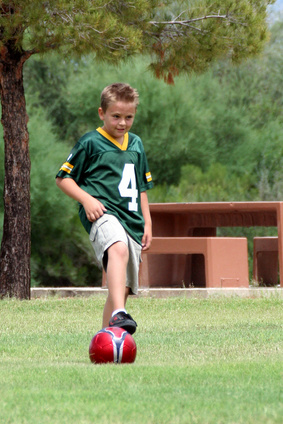
Soccer drills give kids essential skills that they can use during games. These drills also serve as a foundation kids can build upon as they progress to more competitive play. Unfortunately, coaches' and parents' competitive drive often causes children to lose their love of the sport. Remember that you are teaching children, and that children learn through play. Youth soccer has a big dropout rate--about 70 percent by age 12, according to the book, "The Baffled Parent's Guide to Great Soccer Drills." The authors believe this is due to soccer's focus on business and professionalism, and the fact that adults often forget they are teaching young children. But kids who play for fun in their youth are not wasting time. They are actually developing valuable skills. In youth soccer, keeping drills kid-oriented is beneficial.
Using a game-based approach will make soccer more fun for the children as they learn skills. For example, have the kids play Pac-Man, which will help them with dribbling skills. In this game, two players are ghosts. The ghosts don't have a ball, but everyone else does. The players with balls dribble them around, and the ghosts try to kick as many balls out of designated area as they can in two minutes. Players who have balls go out can get their balls, re-enter the area and continue to play.
Don't Let Kids Pick GroupsTo create team unity and prevent sad faces when groups are formed for drills, take over the grouping process: randomly pass out vests during a water break; form groups using birth months, such as January to July on one side and August to December on another; have groups form based on what players are wearing, such as dark or light colors; or have kids raise their hands if they like chocolate versus vanilla. Choose the groups both fairly and quickly. Overseeing this process during drills will help the team develop unity. Have two groups of three or four play in an area of about 10m, and divide the area in half. A team tries to shoot a goal from its own half. Each member has to touch the ball a designated number of times before a shot is taken, and the ball can't stop moving. No goalies are used, but the group on the other side of the area can try to block shots.
Avoid Elimination ContestsAvoid eliminating children as difficulty level increases during drills. The most basic example of this is the high/low game played with a rope in which kids all jump over the rope, followed by the rope being raised. Kids who miss are out while those who clear the higher rope continue on. This goes on until the best player emerges, but this is done at the expense of all the other players. Instead, follow the "slanted rope" concept in which the rope is placed at an angle, allowing all kids to jump successfully along different spots while still challenging themselves. A soccer drill that utilizes this concept is the "Everybody's It" game. Each player has a ball, and tries to tag as many others as she can in a given time. Players who are tagged stay in the game, so whether a player gains two or 20 tags, she is allowed to play at her own level.


